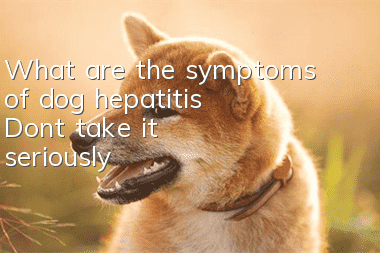What are the symptoms of dog hepatitis? Don’t take it seriously!

What are the symptoms of dog hepatitis? Don’t take it seriously! The clinical features of acute parenchymal hepatitis include jaundice, indigestion, constipation or diarrhea, abdominal pain, neurological symptoms, edema, hemorrhagic diathesis and serological changes, etc. . Prevention and treatment of dog hepatitis?
What are the symptoms of dog hepatitis? In the early stage of the disease, the affected dogs have reduced appetite and food intake, often have diarrhea or constipation, or alternating diarrhea and constipation. The feces smell bad, the feces are gray-green or dark brown, and there is itching of the skin, conjunctiva, and eyelids. Yellow staining of oral mucosa. During the course of the disease, some people become excited first and then become lethargic or even comatose. The liver is enlarged, and the liver dullness area is enlarged during percussion. The affected dogs often have pain during palpation, weakness in posterior drive, and a staggering gait. In severe cases, the detoxification function of the liver is reduced and autotoxicity occurs, often resulting in extreme excitement, ataxia, convulsions or spasms.
What are the symptoms of dog hepatitis? Changes in urine, dark color, sometimes creamy. The urinary bile bin content increases at the beginning of the disease, and then the bilirubin content increases. Urine contains protein, renal epithelial cells, and casts. Serological examination showed elevated activities of alanine aminotransferase, aspartate aminotransferase, alkaline phosphatase and other enzymes.
The principles of prevention and treatment of dog hepatitis are to remove the cause, inhibit inflammation, protect the liver and promote bile, treat symptoms, and strengthen nursing.
(1) To remove the cause and suppress inflammation, the cause should first be identified. If it is caused by feed and toxic substances, it should be corrected quickly; if it is caused by secondary causes, the primary disease should be actively treated first. In order to reduce the inflammatory response, corticosteroids such as hydrocortisone can be used for treatment. When hepatic coma occurs, intravenous injection of mannitol can be used to improve cerebral circulation.
(2) To protect the liver and promote cholestasis, intravenous injection of 25% glucose, vitamin C, vitamin B, inosine, etc. can be used; hepatoprotective drugs such as Gantelex and insulin can also be used, and glutamic acid can be taken , methionine, vitamin B complex, etc. Artificial salts can be used to cleanse the intestines and promote choleretics, and small-dose dermal injections of carbamylcholine or pilocarpine can be used.
(3) Symptomatic treatment, strengthened care, anti-fermentation, hemostasis, sedation and analgesic measures can be taken according to the specific situation, and feeding high-quality, easy-to-digest, high-protein and low-fat feed.
(4) Traditional Chinese medicine treatment adopts treatment methods that mainly protect the liver and promote gallbladder, and promote dampness and diuresis. Such as Yinchen Decoction: 20 grams of Yinchen, 10 grams of gardenia, 5 grams of rhubarb, 6 grams of skullcap, 20 grams of isatis root, decoct in water to remove residue, and take it orally.
- What's going on when a dog sneezes?
- 4 things to consider when choosing a Shiba Inu
- Why do dogs like to eat grass? These are reasons you may not have thought of!
- What should I do if my dog is deficient in calcium? What are the tips for pet parents to supplement calcium for their dogs?
- How to train a German Longhaired Pointer
- Why do dogs and cats develop kidney failure? Can it be treated well?
- Puppies have runny noses, dogs have yellow runny noses
- Chihuahua file introduction and breeding knowledge
- Does golden retriever blood in stool have to be small?
- What are some dogs with good personalities?



